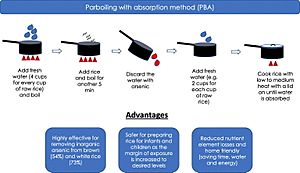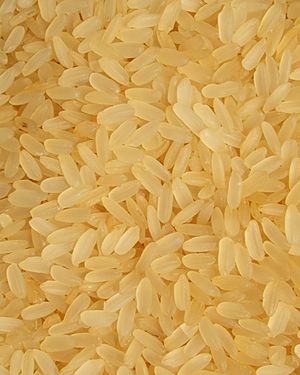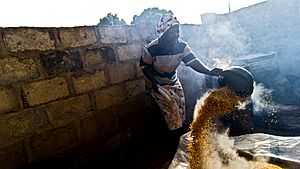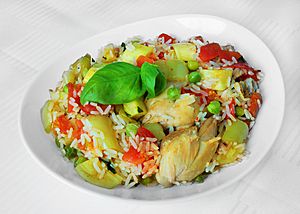Parboiled rice facts for kids
Parboiled rice is a special type of rice. It's also known as converted rice or easy-cook rice. This rice has been partly boiled while it's still in its outer shell, called the husk.
The process of making parboiled rice has three main steps: soaking, steaming, and drying. These steps make the rice easier to handle. They also make it more nutritious and change how it feels when you eat it. Plus, parboiled rice becomes stronger against tiny bugs called weevils. People use this method to prepare rice in many places around the world.
Parboiling helps move important nutrients, like thiamin (a type of vitamin B), from the outer layer (bran) into the inner part of the rice grain (endosperm). This means parboiled white rice is almost as healthy as brown rice.
Contents
How Parboiled Rice is Made
When rice is parboiled, the starches inside it become soft and jelly-like. Then, as the rice cools, these starches become firm again. This process makes the rice grains clear. It also creates a special type of starch that is good for your digestion.
However, this process makes the rice grains harder and look like glass. But don't worry, parboiled rice actually cooks faster! It also turns out firmer and less sticky than regular rice. In places like North America, parboiled rice is often partly or fully cooked before it's sold. Sometimes, extra minerals like zinc or iron are added to make it even healthier.
Older Ways to Make It
In the past, people would first clean the rice. Then, they would soak it in cold water for about 36 to 38 hours. This made the rice absorb enough water. After soaking, the rice was boiled in fresh cold water until the grains started to split. Finally, the rice was dried on special mats, cooled down, and then milled (which means removing the husk).
The Huzenlaub Method
In the 1910s, a German-British scientist named Erich Gustav Huzenlaub and a British chemist named Francis Heron Rogers created a new way to parboil rice. This method helped the rice keep even more of its nutrients. It's now called the Huzenlaub Process.
In this method, the whole rice grain is first dried using a vacuum. Then, it's steamed. After steaming, it's dried again with a vacuum before the husk is removed. This process also makes the rice more resistant to weevils. It also helps the rice cook faster.
Modern Ways to Make It
Today, there are even newer methods. Rice is soaked in hot water and then steamed. This modern way only takes about three hours, much faster than the old methods that took 20 hours. These newer methods also give the rice a yellowish color. Plus, the rice breaks less often when it's milled.
Other ways to parboil rice include using high-pressure steam. There are also different drying methods, like using dry heat or a vacuum.
Nutrition in Parboiled Rice
| Nutritional value per 100 g (3.5 oz) | |
|---|---|
| Energy | 370 kcal (1,500 kJ) |
|
78.68 g
|
|
| Sugars | 0.5 g |
| Dietary fiber | 3.5 g |
|
2.75 g
|
|
|
Protein
|
7.60 g
|
| Vitamins | Quantity
%DV†
|
| Thiamine (B1) |
24%
0.277 mg |
| Riboflavin (B2) |
8%
0.092 mg |
| Niacin (B3) |
31%
4.973 mg |
| Vitamin B6 |
31%
0.407 mg |
| Folate (B9) |
4%
14 μg |
| Vitamin K |
1%
0.9 μg |
| Minerals | Quantity
%DV†
|
| Calcium |
1%
8 mg |
| Iron |
9%
1.16 mg |
| Magnesium |
28%
98 mg |
| Phosphorus |
39%
275 mg |
| Potassium |
7%
219 mg |
| Sodium |
0%
6 mg |
| Zinc |
21%
1.96 mg |
| Other constituents | Quantity |
| Water | 9.82 g |
| †Percentages estimated using US recommendations for adults. | |
When rice is parboiled, it loses some vitamins like thiamin, niacin, biotin, and pantothenic acid. However, compared to regular milling (which removes a lot of nutrients), parboiling helps keep more of these important nutrients. The exact amount of nutrients lost or kept depends on how each company makes the rice. In the United States, parboiled rice is often made even healthier by adding extra nutrients.
Scientists have also looked at how to cook rice to reduce harmful substances like arsenic while keeping the good nutrients. In 2020, they suggested a method that involves parboiling and then letting the rice absorb water. This method helps remove arsenic while keeping the healthy elements.
Images for kids
-
Raw paddy rice.
-
When put in a vacuum, rice loses all the air inside. In a warm water bath, nutrients become more soluble and move out of the bran.

See also
 In Spanish: Arroz vaporizado para niños
In Spanish: Arroz vaporizado para niños









